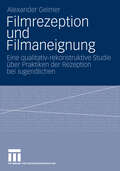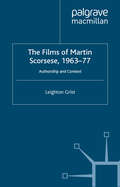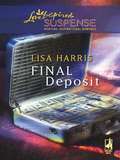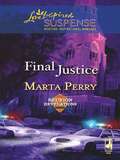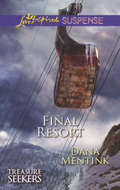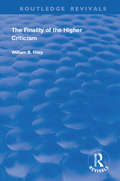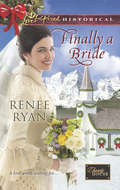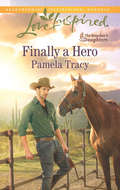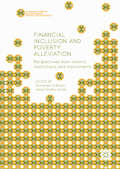- Table View
- List View
Filming the Gods: Religion and Indian Cinema
by Rachel DwyerFilming the Gods examines the role and depiction of religion in Indian cinema, showing that the relationship between the modern and the traditional in contemporary India is not exotic, but part of everyday life. Concentrating mainly on the Hindi cinema of Mumbai, Bollywood, it also discusses India's other cinemas. Rachel Dwyer's lively discussion encompasses the mythological genre which continues India's long tradition of retelling Hindu myths and legends, drawing on sources such as the national epics of the Mahabharata and the Ramayana; the devotional genre, which flourished at the height of the nationalist movement in the 1930s and 40s; and the films made in Bombay that depict India's Islamicate culture, including the historical, the courtesan film and the 'Muslim social' genre. Filming the Gods also examines the presence of the religious across other genres and how cinema represents religious communities and their beliefs and practices. It draws on interviews with film stars, directors and producers as well as popular fiction, fan magazines and the films themselves. As a result, Filming the Gods is a both a guide to the study of film in religious culture as well as a historical overview of Indian religious film.
Filmrezeption und Filmaneignung: Eine qualitativ-rekonstruktive Studie über Praktiken der Rezeption bei Jugendlichen
by Alexander GeimerDiese Arbeit berichtet über Praktiken der Regelung des Verhältnisses zwischen Alltagswelten und Filmwelten; insbesondere: Praktiken der Verknüpfung der eigenen Alltagspraxis (bzw. der diese strukturierenden Wissensbestände) mit einer filmisch inszenierten Praxis. Von besonderem Interesse ist dabei die Modifikation habituell verankerter Orientierungen im Zuge der Film-Zuschauer-Interaktion (produktive Aneignung), die als Ressource einer impliziten und spontanen Bildung zu diskutieren ist. In umfassender Auseinandersetzung mit der Rezeptionsforschung (insbesondere der Cultural Studies) und der aktuellen Bildungsforschung (unter Berücksichtigung von Theorien zur ästhetischen Erfahrung) legt die Arbeit ein theoretisch fundiertes und empirisch gesättigtes Konzept der Aneignung von Filmen vor. Es lässt sich so aus der Perspektive einer praxeologischen Wissenssoziologie und mittels der dokumentarischen Methode das heute inflationär verwendete Konzept der Aneignung präzisieren.
The Films of Martin Scorsese, 1963-77: Authorship and Context
by L. GristA study of Martin Scorsese's early career, from his student short films to New York, New York. As well as discussing the films in detail, they are considered in relation both to the issue of film authorship and a period of American cinema marked by crisis and change. Looking at both Scorsese's film-making and the debates surrounding film authorship, this book is also about American film making in the sixties and seventies - about, in short, authorship and context.
Final Judgement and the Dead in Medieval Jewish Thought (The Littman Library of Jewish Civilization)
by Susan WeissmanThrough a detailed analysis of ghost tales in the Ashkenazi pietistic work Sefer ḥasidim, Susan Weissman documents a major transformation in Jewish attitudes and practices regarding the dead and the afterlife that took place between the rabbinic period and medieval times. She reveals that a huge influx of Germano-Christian beliefs, customs, and fears relating to the dead and the afterlife seeped into medieval Ashkenazi society among both elite and popular groups. In matters of sin, penance, and posthumous punishment, the infiltration of Christian notions was so strong as to effect a radical departure in Pietist thinking from rabbinic thought and to spur outright contradiction of talmudic principles regarding the realm of the hereafter. Although it is primarily a study of the culture of a medieval Jewish enclave, this book demonstrates how seminal beliefs of medieval Christendom and monastic ideals could take root in a society with contrary religious values—even in the realm of doctrinal belief.
Final Judgement and the Dead in Medieval Jewish Thought (The Littman Library of Jewish Civilization)
by Susan WeissmanThrough a detailed analysis of ghost tales in the Ashkenazi pietistic work Sefer ḥasidim, Susan Weissman documents a major transformation in Jewish attitudes and practices regarding the dead and the afterlife that took place between the rabbinic period and medieval times. She reveals that a huge influx of Germano-Christian beliefs, customs, and fears relating to the dead and the afterlife seeped into medieval Ashkenazi society among both elite and popular groups. In matters of sin, penance, and posthumous punishment, the infiltration of Christian notions was so strong as to effect a radical departure in Pietist thinking from rabbinic thought and to spur outright contradiction of talmudic principles regarding the realm of the hereafter. Although it is primarily a study of the culture of a medieval Jewish enclave, this book demonstrates how seminal beliefs of medieval Christendom and monastic ideals could take root in a society with contrary religious values—even in the realm of doctrinal belief.
Final Justice (Reunion Revelations #6)
by Marta PerryHe was a father? A DNA test revealed that Mason Grant had a nine-year-old daughter. He'd had no idea that the woman he'd loved and so tragically lost had been pregnant. Or that his own child had been in the custody of the woman's murderer all these years.
Final Resort (Treasure Seekers #3)
by Dana MentinkDANGER ON THE SLOPES Ava Stanton has no need for love or tales of hidden treasure—until her uncle is kidnapped at her family’s ski resort. Now she needs help from professional treasure hunter Luca Gage…the man she’d tried to forget.
Final Verdict: Dangerous Testimony Ranch Hideout Final Verdict (Mills And Boon Love Inspired Suspense Ser.)
by Jessica R. PatchFATAL JUSTICE
Final Warning (Mills And Boon Love Inspired Ser.)
by Sandra Robbins"Let's play a game…" One e-mail, and radio show host C. J. Tanner becomes a pawn in a madman's game. Only by solving his riddles can she stop the murders. And only Mitch Harmon, her ex-fiancé, can help her put an end to the killer's plans. Mitch knows he has to discover the killer's true identity.
The Final Word: The Caitanya Caritamrita and the Grammar of Religious Tradition
by Tony K StewartThe Gaudiya Vaisnava movement is one of the most vibrant religious groups in all of South Asia. Unlike most devotional communities that flourished in 15th-, 16th-, and 17th-century Bengal, however, the group had no formal founder. Today its devotees are uniform in their devotion to the historical figure of Krishna Caitanya (1486-1533), whom they believe to be not just Krishna incarnate, but Radha and Krishna fused into a single androgynous form. But Caitanya neither founded the community that coalesced around him nor named a successor. Tony Stewart seeks to discover how, with no central leadership, no institutional authority, and no geographic center, a religious community nevertheless comes to successfully define itself, fix its canon and flourish. He finds the answer in the brilliant hagiographical exercise in Sanskrit and Bengali titled the Caitanya Caritamrita (CC) of Krishnadasa Kaviraja.
The Final Word: The Caitanya Caritamrita and the Grammar of Religious Tradition
by Tony K StewartThe Gaudiya Vaisnava movement is one of the most vibrant religious groups in all of South Asia. Unlike most devotional communities that flourished in 15th-, 16th-, and 17th-century Bengal, however, the group had no formal founder. Today its devotees are uniform in their devotion to the historical figure of Krishna Caitanya (1486-1533), whom they believe to be not just Krishna incarnate, but Radha and Krishna fused into a single androgynous form. But Caitanya neither founded the community that coalesced around him nor named a successor. Tony Stewart seeks to discover how, with no central leadership, no institutional authority, and no geographic center, a religious community nevertheless comes to successfully define itself, fix its canon and flourish. He finds the answer in the brilliant hagiographical exercise in Sanskrit and Bengali titled the Caitanya Caritamrita (CC) of Krishnadasa Kaviraja.
The Finality of the Higher Criticism: Or, The Theory of Evolultion and False Theology (Routledge Revivals)
by W. B. RileyFirst published in 1988, this volume was originally published, according to the authors, thanks to a ‘conscious call’. They were ‘fully persuaded that the honor of Christ and the very life of His church are alike endangered by the doubting spirit now brooding over the educational institutions of America.’ The book contains chapters on the prominence of scepticism in schools; the theory of evolution and false theology; and the sacred scriptures.
The Finality of the Higher Criticism: Or, The Theory of Evolultion and False Theology (Routledge Revivals)
by W. B. RileyFirst published in 1988, this volume was originally published, according to the authors, thanks to a ‘conscious call’. They were ‘fully persuaded that the honor of Christ and the very life of His church are alike endangered by the doubting spirit now brooding over the educational institutions of America.’ The book contains chapters on the prominence of scepticism in schools; the theory of evolution and false theology; and the sacred scriptures.
Finally a Bride: The Husband Hunt The Duke's Marriage Mission Wolf Creek Wedding Finally A Bride (Charity House #7)
by Renee RyanSeven years and two broken engagements haven’t erased Garrett Mitchell from Molly Scott’s mind. Her employer insists Molly and Garrett belong together.
Finally a Hero: Reunited With The Cowboy Finally A Hero Coast Guard Courtship (The Rancher's Daughters #1)
by Pamela TracySuddenly a Daddy
Finally a Mother: A Father In The Making Claiming The Doctor's Heart Finally A Mother (Mills And Boon Love Inspired Ser.)
by Dana CorbitA Mother's Second Chance
Finally A Bride: An Unexpected Amish Romance A Family For Easter Finally A Bride (Willow's Haven #4)
by Renee Andrews‘Just friends’ is just perfect…until love finds her at Willow’s Haven
Financial and Accounting Principles in Islamic Finance
by Samir AlamadThis book provides an original account detailing the origins and components of a faith-based accounting system that was founded around 629 CE. By examining the historical development that the accounting systems underwent within the context of faith-based rules and values, the book explains what is meant by the term “faith-based accounting”, together with a discussion of its characteristics in relation to various product structures and the underlying Islamic finance principles. It provides important theoretical and practical contributions by explaining accounting as a value-based science rather than a value-free object or abstract. This book explores the way in which religious rules act as a directive for accounting and auditing practices in IFIs. Through which the concept of money and digital currency within the theory of money and how it is enacted in a faith-based context, amid differences of opinions among its actors, is examined. This is an important foundation to explain Islamic accounting and includes how this outcome would shape the faith-based view regarding the new phenomenon of digital currency (DC). Also featured is the concept of paper money within the theory of money and how it is enacted in a faith-based legal framework by identifying two core concepts of today’s Fiat money as being a single genus or multi-genera money. This book is not merely an academic work, nor is it a pure practitioner guide; rather, it is a robust work that combines both. It marries rigorous academic research and theories with practical industry experiences. The book provides a clear and concise guide to accounting in Islamic economics and finance and how Islamic financial institutions could meet the applicable faith-based rules in their accounting practices.
Financial Inclusion and Poverty Alleviation: Perspectives from Islamic Institutions and Instruments (Palgrave Studies in Islamic Banking, Finance, and Economics)
by Muhamed Zulkhibri Abdul Ghafar IsmailThis book explores the relationships between financial inclusion, poverty and inclusive development from Islamic perspectives. Financial inclusion has become an important global agenda and priority for policymakers and regulators in many Muslim countries for sustainable long-term economic growth. It has also become an integral part of many development institutions and multilateral development banks in efforts to promote inclusive growth. Many studies in economic development and poverty reduction suggest that financial inclusion matters. Financial inclusion, within the broader context of inclusive development, is viewed as an important means to tackle poverty and inequality and to address the sustainable development goals (SDGs). This book contributes to the literature on these topics and will be of interest to researchers and academics interested in Islamic finance and financial inclusion.
Financial Inclusion and Poverty Alleviation: Perspectives from Islamic Institutions and Instruments (Palgrave Studies in Islamic Banking, Finance, and Economics)
by Muhamed Zulkhibri Abdul Ghafar IsmailThis book explores the relationships between financial inclusion, poverty and inclusive development from Islamic perspectives. Financial inclusion has become an important global agenda and priority for policymakers and regulators in many Muslim countries for sustainable long-term economic growth. It has also become an integral part of many development institutions and multilateral development banks in efforts to promote inclusive growth. Many studies in economic development and poverty reduction suggest that financial inclusion matters. Financial inclusion, within the broader context of inclusive development, is viewed as an important means to tackle poverty and inequality and to address the sustainable development goals (SDGs). This book contributes to the literature on these topics and will be of interest to researchers and academics interested in Islamic finance and financial inclusion.
Financial Instruments and Cash Waqf: Bridging Islamic Finance with Sustainable Development Goals
by Ahmed Tahiri-JoutiThe book, organized in three parts, offers a guide to constructing financial instruments based on cash waqf in alignment with the Sustainable Development Goals. The first part discusses the alignment between the Shari'ah economic objectives and the SDGs, the Islamic social finance concept, its instruments and institutions and the intersection between Islamic finance and Islamic social finance. The second part presents a product structure that is based on cash waqf and is targeting the SDGs specifically. Some of these product structures involve zakat collection. The third part of the book presents the methodology to gather all these product structures in a national cash waqf ecosystem that is targeting SDGs. The aim of this ecosystem is to increase the impact of the various initiatives and instruments. In addition to this, the third part of the book presents the concept of Waqf offshore centers and the methodology to conceive and implement them. The aim of these Waqf offshore centers is to connect national cash waqf ecosystems and individuals with investment opportunities bringing more impact. This book will be of interest to academics, researchers, and practitioners of not only Islamic finance but sustainable finance.
Financial Reporting for Islamic Financial Institutions: Accounting and Auditing Standards, Interpretation and Application (Routledge Studies in Accounting)
by Abdul Rauf Mahar Ayesha Bhatti Muhammad Junaid Ashraf Asfand Zubair MalikMainstream accounting rules, namely International Financial Reporting Standards (IFRS), used in conventional banking, employ financial logics and principles which are at odds with Shariah and therefore unsuitable for reporting the results of Islamic banks. The book is an effort to explain the Islamic accounting principles and practices for Islamic Financial institutions and to juxtapose them to mainstream accounting principles in a simple and practical manner. The book begins with an overview of the Islamic Finance environment, the rationale for Islamic accounting and a brief introduction of AAOIFI (Accounting and Auditing Organization for Islamic Financial Institutions), the professional body responsible for the issuance of Islamic accounting standards. The main features of the AAOIFI Conceptual Framework and its comparison with IFRS framework are covered in Chapter 2. Chapters 3-9 cover the accounting treatment of the major Islamic finance products including trade-based (Murabaha, Salam and Istisna’a), rental-based (Ijarah) and risk-sharing based products (Mudarabah and Musharakah). Given the significance and complexity of Islamic bonds (Sukuk) for the Islamic finance industry, Chapter 10 discusses the basic accounting and reporting issues vis-à-vis Sukuk, leaving more complex issues for advanced texts on the topic. Zakah accounting (charity) and provisions and impairments are covered in Chapters 11 and 12. The chapters are arranged so that they start with a discussion of the product itself, followed by the AAOIFI accounting treatment and ending with the IFRS perspective. Each chapter begins with the learning objectives and a cover story and closes with a summary of the learning objectives. To facilitate the learning of readers, each chapter contains a glossary of the terms introduced as well as end of chapter multiple choice questions. In addition, each chapter includes practical insights and concept checks to enhance and test the understanding of the readers. This will be a useful guide for students, academics and practitioners concerned with the subject of financial reporting in Islamic Institutions.
Financial Reporting for Islamic Financial Institutions: Accounting and Auditing Standards, Interpretation and Application (Routledge Studies in Accounting)
by Abdul Rauf Mahar Ayesha Bhatti Muhammad Junaid Ashraf Asfand Zubair MalikMainstream accounting rules, namely International Financial Reporting Standards (IFRS), used in conventional banking, employ financial logics and principles which are at odds with Shariah and therefore unsuitable for reporting the results of Islamic banks. The book is an effort to explain the Islamic accounting principles and practices for Islamic Financial institutions and to juxtapose them to mainstream accounting principles in a simple and practical manner. The book begins with an overview of the Islamic Finance environment, the rationale for Islamic accounting and a brief introduction of AAOIFI (Accounting and Auditing Organization for Islamic Financial Institutions), the professional body responsible for the issuance of Islamic accounting standards. The main features of the AAOIFI Conceptual Framework and its comparison with IFRS framework are covered in Chapter 2. Chapters 3-9 cover the accounting treatment of the major Islamic finance products including trade-based (Murabaha, Salam and Istisna’a), rental-based (Ijarah) and risk-sharing based products (Mudarabah and Musharakah). Given the significance and complexity of Islamic bonds (Sukuk) for the Islamic finance industry, Chapter 10 discusses the basic accounting and reporting issues vis-à-vis Sukuk, leaving more complex issues for advanced texts on the topic. Zakah accounting (charity) and provisions and impairments are covered in Chapters 11 and 12. The chapters are arranged so that they start with a discussion of the product itself, followed by the AAOIFI accounting treatment and ending with the IFRS perspective. Each chapter begins with the learning objectives and a cover story and closes with a summary of the learning objectives. To facilitate the learning of readers, each chapter contains a glossary of the terms introduced as well as end of chapter multiple choice questions. In addition, each chapter includes practical insights and concept checks to enhance and test the understanding of the readers. This will be a useful guide for students, academics and practitioners concerned with the subject of financial reporting in Islamic Institutions.
The Financing of John Wesley's Methodism c.1740-1800
by Dr Clive Murray NorrisThe dominant activities of the eighteenth century Wesleyan Methodist Connexion, in terms of expenditure, were the support of itinerant preaching, and the construction and maintenance of preaching houses. These were supported by a range of both regular and occasional flows of funds, primarily from members' contributions, gifts from supporters, various forms of debt finance, and profits from the Book Room. Three other areas of action also had significant financial implications for the movement: education, welfare, and missions. The Financing of John Wesley's Methodism c.1740-1800 describes what these activities cost, and how the money required was raised and managed. Though much of the discussion is informed by financial and other quantitative data, Clive Norris examines a myriad of human struggles, and the conflict experienced by many early Wesleyan Methodists between their desire to spread the Gospel and the limitations of their personal and collective resources. He describes the struggle between what Methodists saw as the promptings of Holy Spirit and their daily confrontation with reality, not least the financial constraints which they faced.

